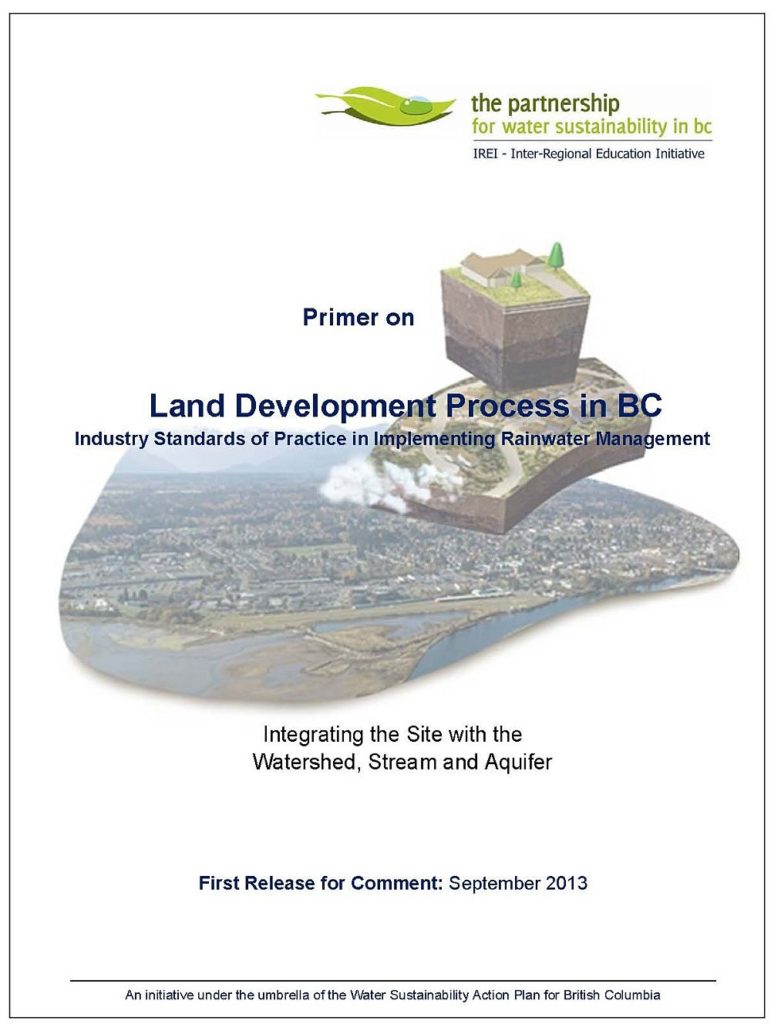BEYOND THE GUIDEBOOK PRIMER SERIES: “The Primer is a ‘bridging document’ – it illustrates how to seamlessly integrate the legal and administrative parts of land development,” stated Tim Pringle when the Primer on Land Development Process in BC was released by the Partnership for Water Sustainability (September 2013)
Note to Reader:
This Primer is the fourth in a series of guidance documents released by the Partnership for Water Sustainability since November 2011. Core concepts presented in these companion documents provide an educational foundation for rainwater management in a watershed context. To download a copy, click on Primer on Land Development Process in BC: Industry Standards of Practice in Implementing Rainwater Management.
The Partnership’s purpose in developing the Primers is to inform and educate infrastructure, land use and environmental professionals about implementing actions at the site scale that will achieve desired outcomes at the watershed scale.
These guidance documents form the basis for knowledge-transfer via the Georgia Basin Inter-Regional Education Initiative (IREI). The foundation document for the series is Stormwater Planning: A Guidebook for British Columbia, released in 2002.
Design with Nature to Mimic the Natural Water Balance
“Rainwater management must be a key consideration in urban development and redevelopment. Provincial direction is to mimic the natural Water Balance to protect stream and watershed health. This is the ‘designing with nature’ strategy,” states Tim Pringle, President of the Partnership for Water Sustainability in BC, in the preface to the Primer on Land Development Process in BC.
 “This Primer supports implementation of targets and actions listed in Living Water Smart: British Columbia’s Water Plan. The targets and actions establish expectations as to how land will be (re)developed.”
“This Primer supports implementation of targets and actions listed in Living Water Smart: British Columbia’s Water Plan. The targets and actions establish expectations as to how land will be (re)developed.”
“The focus of the Primer is on the steps in the Land Development Process. The Primer provides both context and general guidance.”
“The Primer is a ‘bridging document’ because it illustrates how to seamlessly integrate the legal and administrative parts of the Land Development Process through the designing with nature and rainwater management lens.”
Target Audiences in Local Government Setting
“Target audiences include local government staff, land developers and design professionals who are implementing rainwater management systems at the site, subdivision, neighbourhood or community scales,” continues Tim Pringle.
“While much attention is given to the technical and legal aspects, we are not aware of anyone who has addressed administration. At the heart of the Primer, then, is the discussion at the end of Section 6 about Administrative Process Requirements. This piece of the puzzle is the key to implementation of effective rainwater management systems on private property.”
“The Primer will assist practitioners whose work addresses land subdivision concerns. The Partnership invites comments and suggestions on this first version of the Primer, which we will update in the future to reflect feedback,” concludes Tim Pringle.
Recognize there is a Knowledge Vacuum
“There is a knowledge vacuum in BC. and this has resulted in a gap between awareness of what needs to be done, and the capability of local government staff and others to implement standards of practice that will ultimately achieve the goal of mimicking the natural Water Balance following development,” states Jim Dumont, the Partnership’s Engineering Applications Authority, and the principal author of the Primer on Land Development Process.
 “The land development sector is experiencing the consequences of the demographic shift that is occurring society-wide. There is staff turnover; and long-term experience and wisdom is not being passed on to the next generation. Increasingly, it seems that few administrative staff and even fewer members of the general public really understand the land development process.”
“The land development sector is experiencing the consequences of the demographic shift that is occurring society-wide. There is staff turnover; and long-term experience and wisdom is not being passed on to the next generation. Increasingly, it seems that few administrative staff and even fewer members of the general public really understand the land development process.”
“Before we can even begin to look at solutions we need to recognize the knowledge vacuum and provide information to fill it. When there is a knowledge base, then solutions are much easier to implement. To fill this educational need, the goal of the Primer on Land Development Process in BC is to provide practitioners with an understanding of the legal and administrative framework for land development,” concludes Jim Dumont.
To Learn More:
To download a copy, click on Primer on Land Development Process in BC: Industry Standards of Practice in Implementing Rainwater Management.
For a section-by-section synopsis of the Primer storyline, click on the following link to Table 1. Sections 1 and 2 establish the regulatory context and describe the Primer scope, respectively. To achieve the educational objectives, the balance of the Primer is organized in five sections: Sections 3 and 4 provide context; Sections 5 and 6 provide guidance; and Section 7 consolidates what is important to know.


